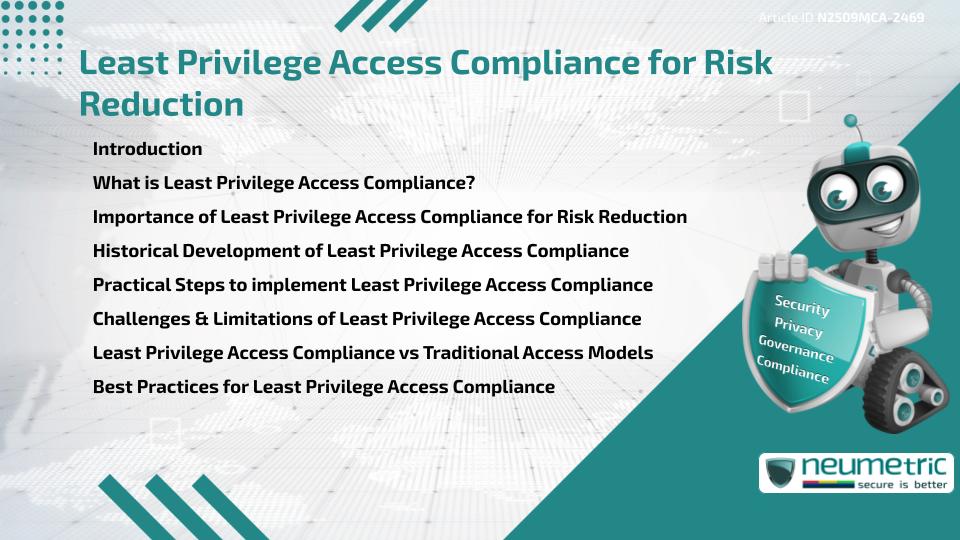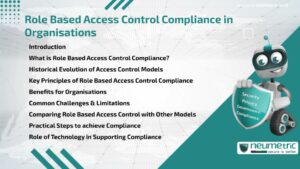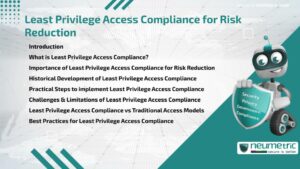Table of Contents
ToggleIntroduction
Least Privilege Access Compliance is the structured approach to ensuring that users, applications & devices only receive the minimum level of access required to perform their roles. By aligning with Regulatory Standards & internal Security Policies, Least Privilege Access Compliance reduces Risks of Data Breaches, insider Threats & Regulatory penalties. It is a fundamental principle of modern Cybersecurity, balancing operational efficiency with strong Risk reduction. This article explores its meaning, importance, history, practical steps, challenges, comparisons & Best Practices.
What is Least Privilege Access Compliance?
Least Privilege Access Compliance refers to enforcing the Principle of Least Privilege [PoLP] while adhering to Industry Regulations & organisational Policies. In practice, it means restricting User accounts so they only access the information or systems they truly need. Much like giving house keys only for specific rooms instead of the entire property, Compliance ensures tighter control & easier monitoring of permissions.
Importance of Least Privilege Access Compliance for Risk Reduction
Least Privilege Access Compliance is essential because it:
- Prevents Insider Threats: Reduces damage potential from malicious or careless users.
- Protects Sensitive Data: Limits access to regulated information such as health or Financial records.
- Supports Compliance: Meets requirements under standards like GDPR, HIPAA & ISO 27001.
- Improves Security Posture: Provides layered defense against breaches & malware spread.
Without Least Privilege Access Compliance, organisations face unnecessary Risks of data misuse, regulatory fines & reputational harm.
Historical Development of Least Privilege Access Compliance
The concept of least privilege dates back to the early days of computer science in the 1970s. Initially applied in Military & Government computing environments, it became a core security principle as commercial IT systems grew in complexity. With the rise of regulatory frameworks in the late twentieth century, Least Privilege Access Compliance evolved from a best practice to a mandatory requirement for many industries.
Historical context highlights its enduring role in both IT Security & Compliance programs.
Practical Steps to implement Least Privilege Access Compliance
Organisations can achieve Least Privilege Access Compliance by following these steps:
- Role-Based Access Control: Assign permissions based on job functions.
- Regular Audits: Review & adjust permissions to prevent privilege creep.
- Multi-Factor Authentication: Strengthen Access Control with layered verification.
- Automated Tools: Use Identity & Access Management platforms to enforce Policies.
- Documentation: Maintain Records to demonstrate Compliance during Audits.
Challenges & Limitations of Least Privilege Access Compliance
Although beneficial, Least Privilege Access Compliance presents challenges:
- Complex Systems: Modern IT environments require managing thousands of permissions.
- User Frustration: Restricting access can slow down productivity if not balanced correctly.
- Resource Constraints: Smaller organisations may lack staff or tools for proper enforcement.
- Regulatory Overlap: Aligning with multiple frameworks increases administrative burden.
These challenges demonstrate why careful planning & ongoing management are critical.
Least Privilege Access Compliance vs Traditional Access Models
Traditional access models often grant broader permissions for convenience, relying on trust within a network perimeter. Least Privilege Access Compliance, by contrast, enforces minimal permissions to reduce Risk exposure. This can be compared to airport security: while traditional models allow wide movement once inside, least privilege ensures each gate or area requires additional checks.
Best Practices for Least Privilege Access Compliance
To sustain Least Privilege Access Compliance, organisations should:
- Automate privilege reviews with identity Governance tools.
- Apply just-in-time access, granting temporary privileges only when necessary.
- Integrate least privilege into Employee onboarding & offboarding.
- Foster a culture of Security Awareness to encourage adherence.
- Align Controls with evolving regulations & Industry Standards.
These Best Practices ensure Compliance efforts reduce Risks without hindering daily operations.
Conclusion
Least Privilege Access Compliance is a vital element of Risk reduction strategies. By ensuring users & systems operate with minimal necessary permissions, organisations achieve stronger security & regulatory alignment. With a historical foundation, practical steps & proven Best Practices, Least Privilege Access Compliance delivers resilience against insider Threats & external attacks alike.
Takeaways
- Least Privilege Access Compliance limits access to reduce Security Risks.
- It originated in military computing & became a Compliance requirement over time.
- Practical steps include Audits, Role-based Access & Automation.
- Challenges include system complexity, user frustration & regulatory overlap.
- Best Practices integrate automation, just-in-time access & cultural awareness.
FAQ
What is Least Privilege Access Compliance?
It is the enforcement of least privilege principles while meeting Regulatory & Policy requirements.
Why is Least Privilege Access Compliance important?
It prevents insider Threats, protects Sensitive Data & supports Compliance frameworks.
How is Least Privilege Access Compliance implemented?
It is achieved through Role-based Access, regular Audits, Multi-factor Authentication & automated tools.
What challenges arise with Least Privilege Access Compliance?
Challenges include complex IT environments, user frustration & overlapping regulations.
How does Least Privilege Access Compliance differ from traditional access models?
It restricts access to the minimum required, unlike traditional models that grant broad permissions.
Can small organisations apply Least Privilege Access Compliance?
Yes, by using simple tools, training Employees & conducting periodic Access Reviews.
What are Best Practices for Least Privilege Access Compliance?
Best Practices include just-in-time access, automation, documentation & fostering a Compliance culture.
Need help for Security, Privacy, Governance & VAPT?
Neumetric provides organisations the necessary help to achieve their Cybersecurity, Compliance, Governance, Privacy, Certifications & Pentesting needs.
Organisations & Businesses, specifically those which provide SaaS & AI Solutions in the Fintech, BFSI & other regulated sectors, usually need a Cybersecurity Partner for meeting & maintaining the ongoing Security & Privacy needs & requirements of their Enterprise Clients & Privacy conscious Customers.
SOC 2, ISO 27001, ISO 42001, NIST, HIPAA, HECVAT, EU GDPR are some of the Frameworks that are served by Fusion – a SaaS, multimodular, multitenant, centralised, automated, Cybersecurity & Compliance Management system.
Neumetric also provides Expert Services for technical security which covers VAPT for Web Applications, APIs, iOS & Android Mobile Apps, Security Testing for AWS & other Cloud Environments & Cloud Infrastructure & other similar scopes.
Reach out to us by Email or filling out the Contact Form…





